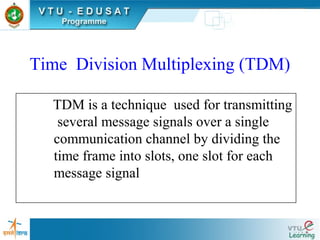
104623 time division multiplexing (transmitter, receiver,commutator)
- 1. Time Division Multiplexing (TDM) TDM is a technique used for transmitting several message signals over a single communication channel by dividing the time frame into slots, one slot for each message signal
- 4. Samples of Signal -1 time 0 Ts 2Ts g1(t)
- 5. Samples of signal - 2 Ts Ts g2(t)
- 6. Multiplexing of TWO signals 0 Ts 2Ts
- 7. TDM-PAM for 3 signals Time 1 1 12 2 2 3 3 3
- 8. TDM-PAM for 4 signals. 1 1 1 2 2 2 3 3 3 4 4 4 Time
- 11. TDM-PAM Types of TDM: – Synchronous TDM – Asynchronous TDM
- 12. Synchronous TDM 1. Same Sampling rate for all signals. 2. Minimum Sampling rate = twice the maximum frequency of all the signals. 3. Total number of samples transmitted per second is equal to N times the sampling rate, Fs plus sync pulses. 4. Transmission Bandwidth = N. Fs/2
- 13. Asynchronous TDM 1. Different Sampling rate for different. signals. 2. Sampling rate of a signal = twice the maximum frequency of that signal. 3. Total number of samples transmitted per second is equal to Sum of samples of all the signals plus sync pulses.
- 14. Asynchronous TDM 4. Transmission Bandwidth = Half the total number of samples transmitted. 5. Bandwidth is less for Asynchronous TDM. 6. Design of Commutator / Decommutator is difficult.
- 15. Problem-1 Two low-pass signals of equal bandwidth are sampled and time division multiplexed using PAM. The TDM signal is passed through a Low-pass filter & then transmitted over a channel with a bandwidth of 10KHz. Continued….
- 16. Problem –1 continued a) What is maximum Sampling rate for each Channel? b) What is the maximum frequency content allowable for each signal?
- 17. Problem –1 : Solution Channel Bandwidth = 10 KHz. Number of samples that can be transmitted through the channel = 20K Maximum Sampling rate for each channel = 10K Samples/sec. Maximum Frequency for each Signal = 5KHz
- 18. Problem –2 Two signals g1(t) and g2(t) are to transmitted over a common channel by means of TDM. The highest frequency of g1(t) is 1KHz and that of g2(t) is 1.3KHz. What is the permissible sampling rate? Ans: 2.6K samples/sec and above. { Synchronous TDM}
- 19. Problem-3 Q. 24 voice signals are sampled uniformly and then time division multiplexed . The sampling operation uses the flat-top samples with 1microsec duration. The multiplexing operation includes provision for Synchronization by adding an extra pulse of sufficient amplitude and also 1micro second. Contd…
- 20. Problem-3 Contd.. Assuming a sampling rate of 8KHz, calculate the spacing between successive pulses of the multiplexed signal.
- 21. Problem-3: Solution In One frame, Total number of pulses = 25. Time duration for one time frame = Ts = 125µ seconds. Time duration utilized by pulses = 25µ sec Time spacing between successive pulses = (125- 25)/25 = 4µ sec.
- 22. Problem-4 Three independent message signals of bandwidths 1KHz, 1KHz and 2KHz respectively are to be transmitted using TDM scheme. Determine a) Commutator segment arrangement b) Speed of the commutator if all the signals are sampled at its Nyquist rate. c) Minimum Transmission bandwidth.
- 23. Problem-4: Solution a) Commutator Segment arrangement. g1(t) g2(t) g3(t) 12 3 4
- 24. Problem-4 : Solution. 1 1 1 3 3 3 2 2 2 3 3 3 Time
- 25. Problem-4: Solution b) Total number of Samples to be transmitted per second = 8K samples/sec. Number of Commutator segments = 4 Speed of Commutator = 2000 rotations/sec. c) Transmission Bandwidth = 4000 Hz.
- 26. Problem-5. Q. Eight independent message signals are sampled and time multiplexed using PAM. Six of the message signals are having a bandwidth of 4KHz and other two have bandwidth of 12KHz. Compare the transmission bandwidth requirements of Synchronous TDM and Asynchronous TDM.
- 27. Conclusions